chapter 5: sex determination and sex chromosomes
1/135
There's no tags or description
Looks like no tags are added yet.
Name | Mastery | Learn | Test | Matching | Spaced |
|---|
No study sessions yet.
136 Terms
sexual differentiation is
crucial to many life cycles but not all
in multicellular sexually reproducing organisms, its important to distinguish between
-male/female determination
-primary sexual determination
-secondary sexual differentiation
male/female determination can be based on
specific chromosomes
primary sexual differentiation
involves only the gonads where gametes are produced
secondary sexual differentiation
involves the overall appearance of the organism
secondary sexual differentiation includes clear differentiation in
such organs as mammary glands and external genitalia
male/female determinations varies between
species
plants and animals that contain only male OR female reproductive organs are
unisexual (dioecious or gonochoric)
plants and animals that contains both male AND female reproductive organs are
bisexual (monoecious or hermaphroditic)
bisexual plants and animals can produce
both male and female gametes
in some species male/female differentiation occurs in
different tissues of the same individual
in maize (Zea mays)
-diploid sporophyte stage predominates
-both male + female structures are present on adult plant
dominance of diploid sporophyte stage in maize indicates that
sex determination must occur differently in different tissues of the same plant
sexual determination can be
genetically determined and regulated
mutant genes can cause
sex reversal
when homozygous, all mutations classified as tassel seed (ts) interfere with
tassel production and induce production of female structures instead
recessive maize mutations
-silkless (sk)
-barren (ba)
recessive mutations sickles (sk) and barren (ba) interfere with the
development of the pistil, resulting in plants with only male-functioning reproductive organs
XY systems
-mammals
-some insects
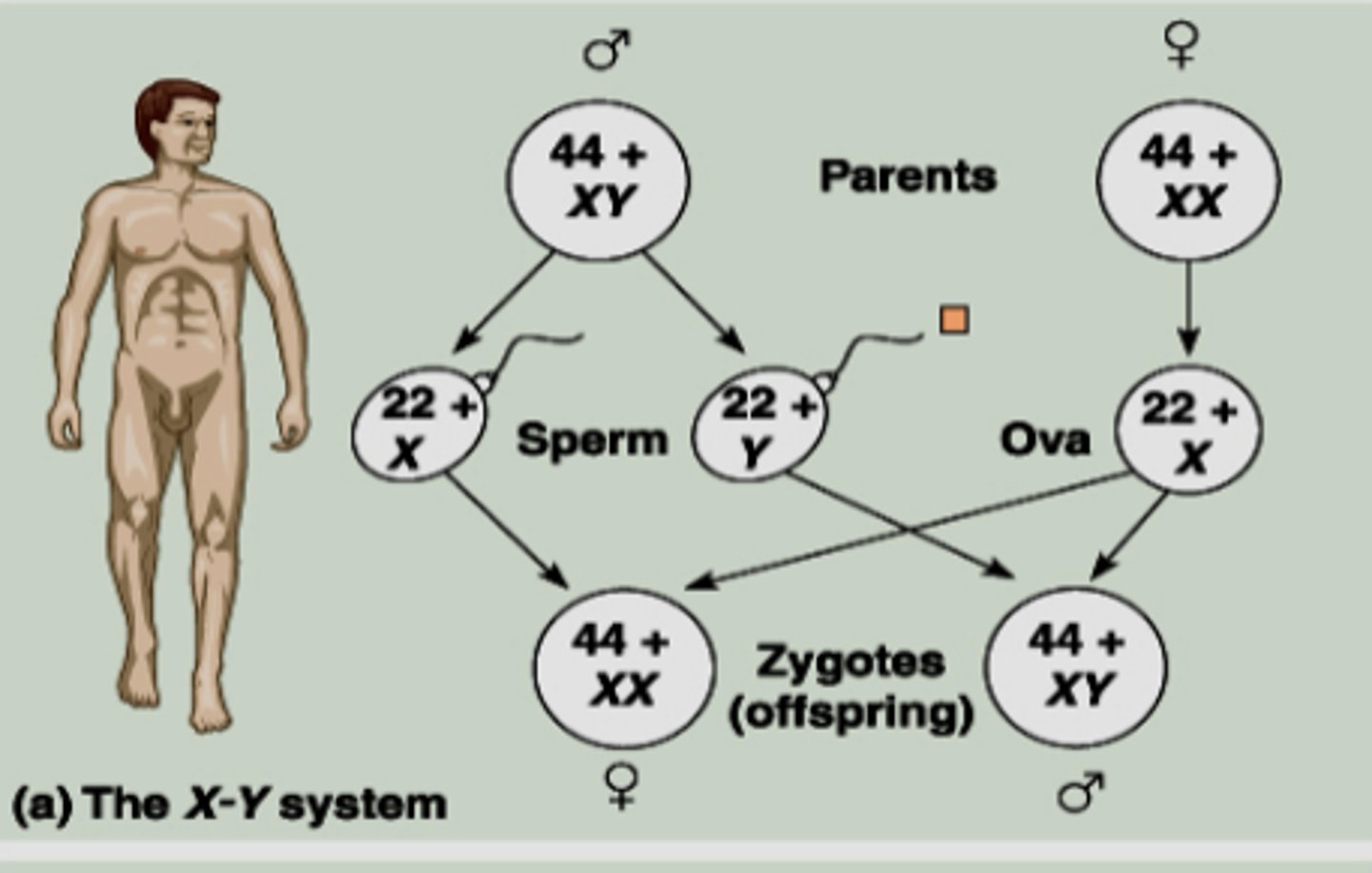
XO system
some insects

ZW system
-reptiles
-birds
-some amphibians
-insects

no special sex chromosomes
-plants
-fungi

XX/XY Lygaeus mode of sex determination
-female gametes all have an X chromosome
-male gametes have either an X or a Y chromosome
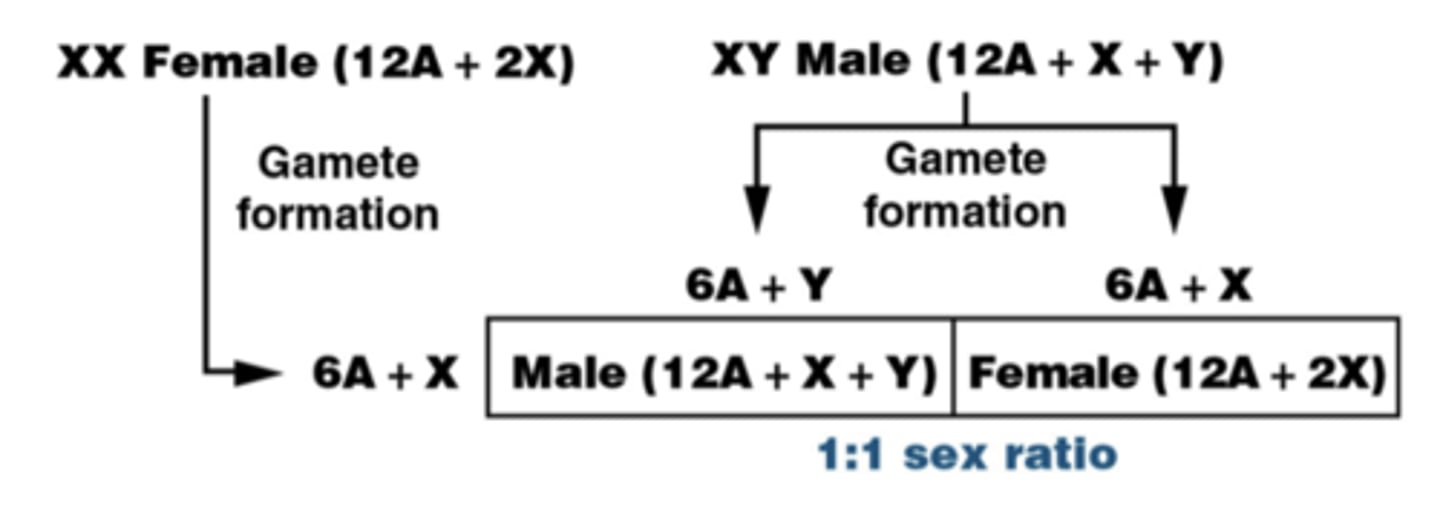
zygotes with two X chromosomes result in
female offspring
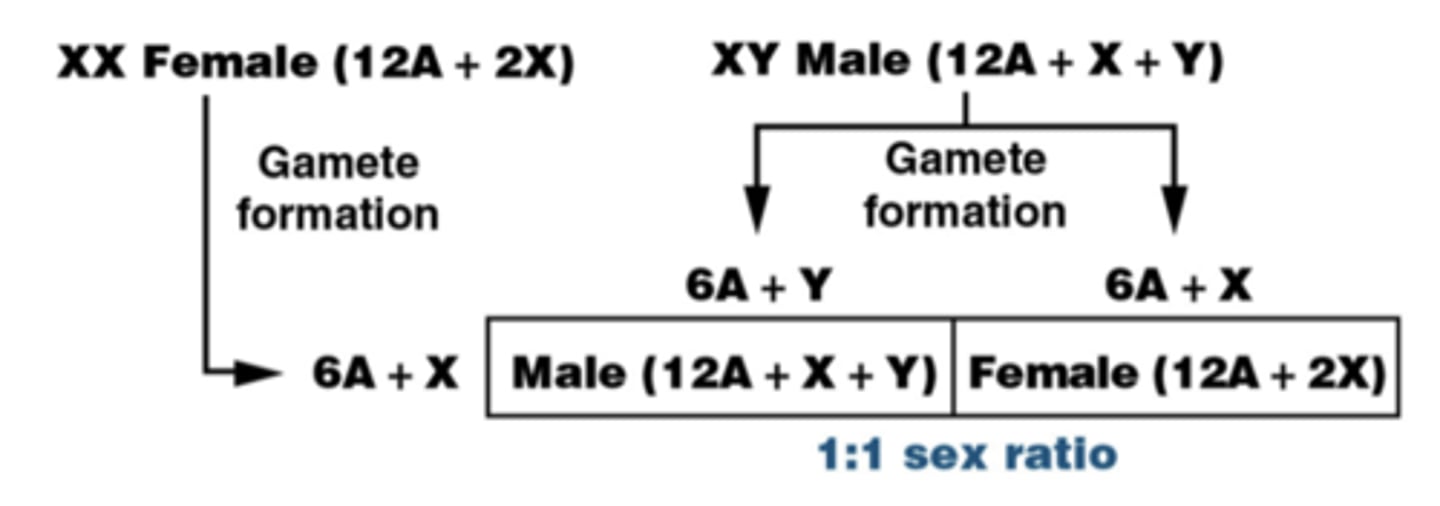
homogametous
two X chromosomes
zygotes with one X and one Y chromosome result in
male offspring
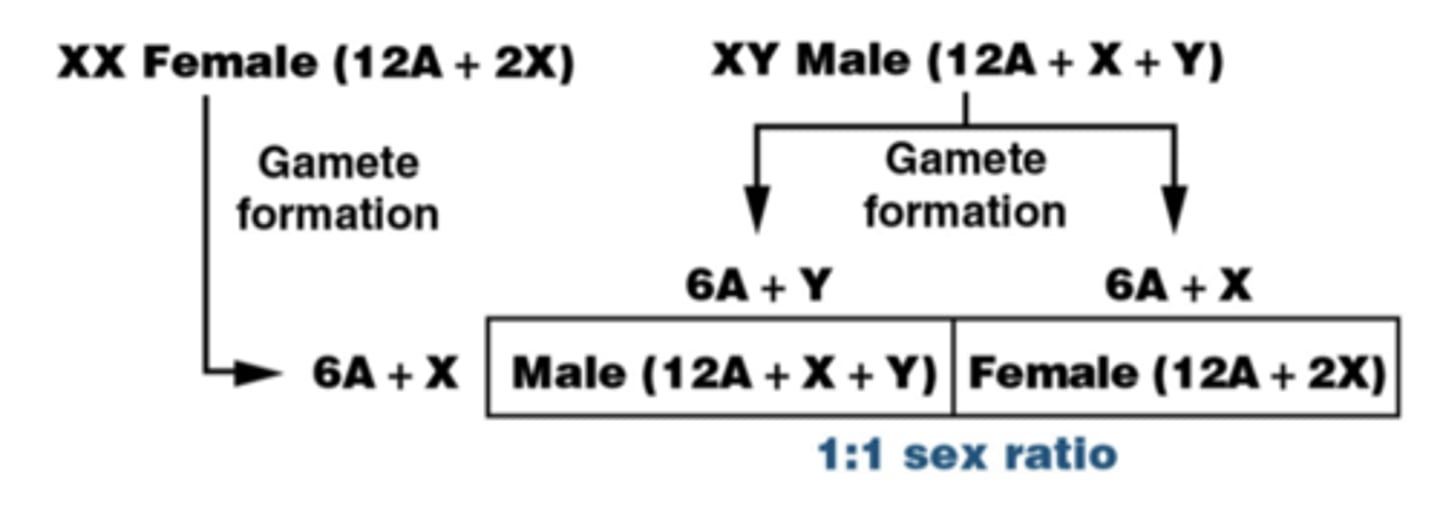
heterogamous
one X and one Y chromosome
many organisms use an X chromosome system for
sexual determination
XX/XO protenor (butterfly) mode of sex determination depends on
the random distribution of the X chromosome into half of the male gametes
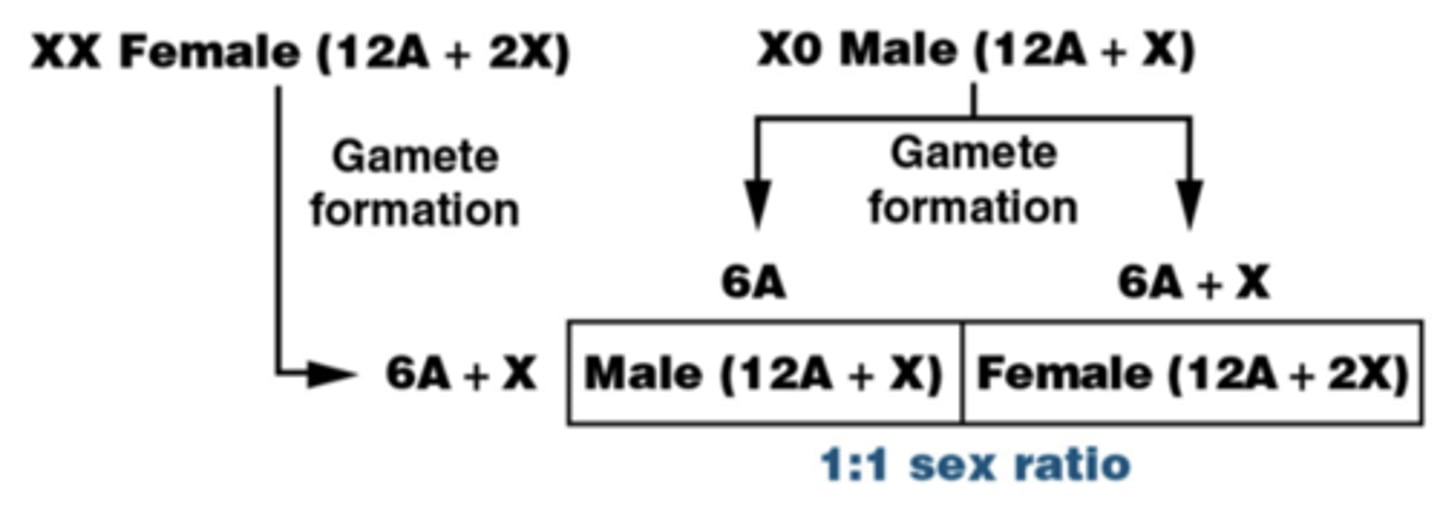
in XX/XO the presence of two X chromosomes in the zygote results in
female offspring
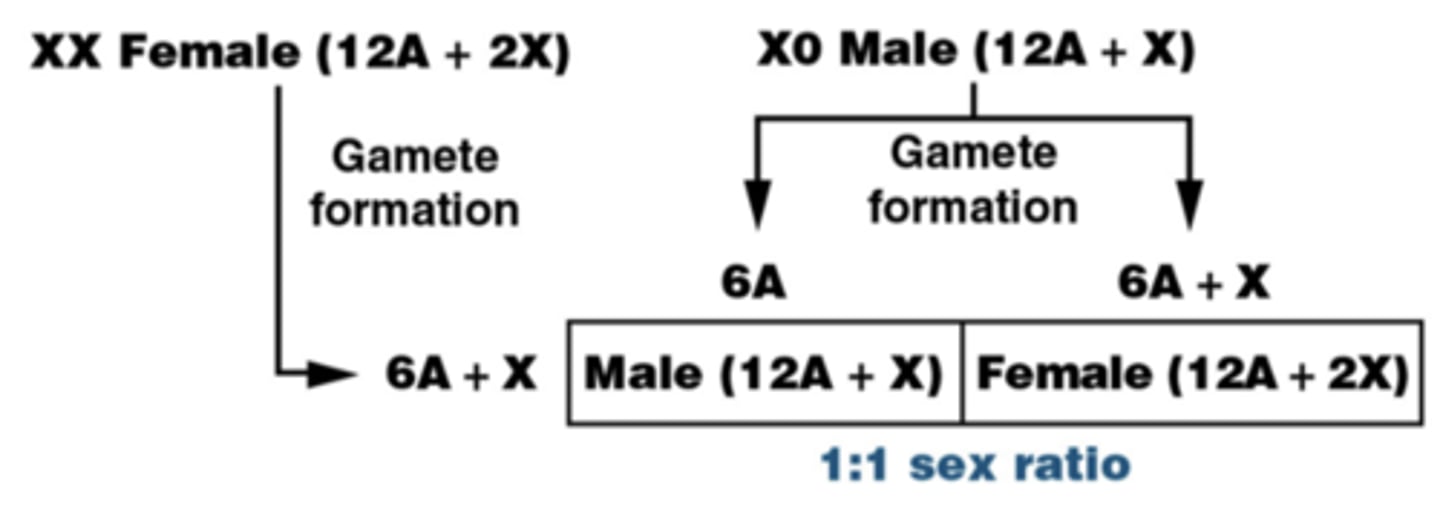
in XX/XO the presence of only one X chromosome results in
male offspring
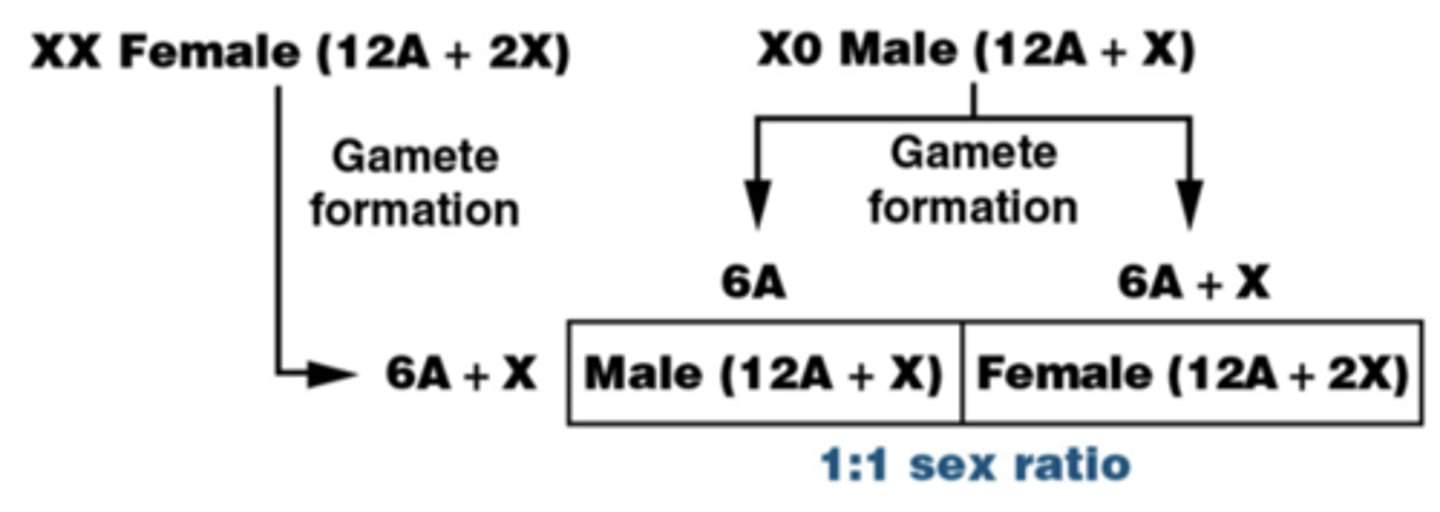
in ZZ/ZW system males are
not always the heterogametic sex
in some ZZ/ZW organisms, females are the
heterogametic sex
ZW
females are heterogametic sex
ZZ
males are the homogametic sex
example of Z/W system
chickens
ratio of X chromosomes to sets of autosomes determines
sex in drosophila
in drosophila, Y chromosome does not
determine sex
in drosophila Y does not determine
sex but it is needed for fertility
in drosophila sex is determined by the
ratio of X chromosomes to the haploid sets of autosomes (A)
normal drosophila female
AA and XX
-1:1
normals drosophila male
AA and XY
-1;2
in contrast to mammals, the X chromosome on male drosophila is
unregulated so that transcription levels equal that of XX female
with respect to primary sex determination, male gametes containing one of each autosome plus a Y chromosome result in
male offspring because they lack an X chromosome
genic balance theory
threshold of maleness if reached when X:A ratio is 1:2 (X:2A) but the presence of additional X (XX:2A) alters re balance + results in female differentiation
chromosome formulation
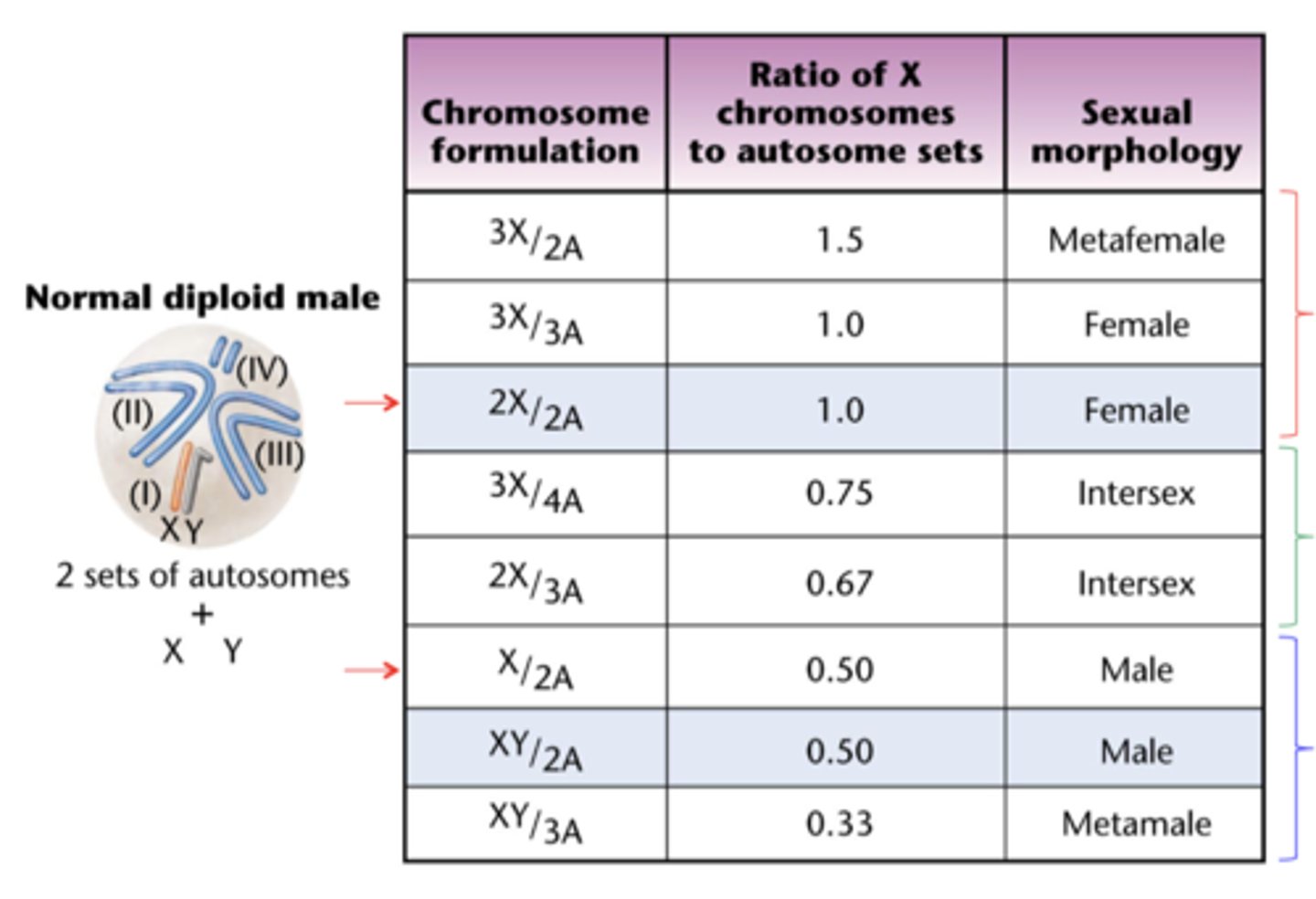
C. elegans
-model species
-has two sexual phenotypes
C elegan males with one testes have only
-one X chromosome
-no Y
-hermaphrodites
c. elegant hermaphrodites
have both testes and ovaries
-have two X chromosomes, no Y
hermaphrodite eggs are fertilized by
stored sperm-self fertilization
majority of c. elegan offspring are
hermaphrodites
less than 1% of c. elegans are
males
in some species, sex is not
genetically determined
Temperature-dependent sex determination (TSD)
Environment, specifically temperature, has profound influence on sex determination
for crocs, turtles, and lizards, sex determination is achieved according to the
incubation temperature of eggs is during a critical period of embryonic development
many reptile species do use
ZZ/WW or XX/XY, in others TSD is the norm
in reptiles, temperature can
influence sex determination
three different patterns of temperature sex determinations in reptiles
1. low temps yield 100% females, high temps yield 100% males
2. exact opposite occurs
3. low and high temps yield 100% females, intermediate temps yield various proportions of males
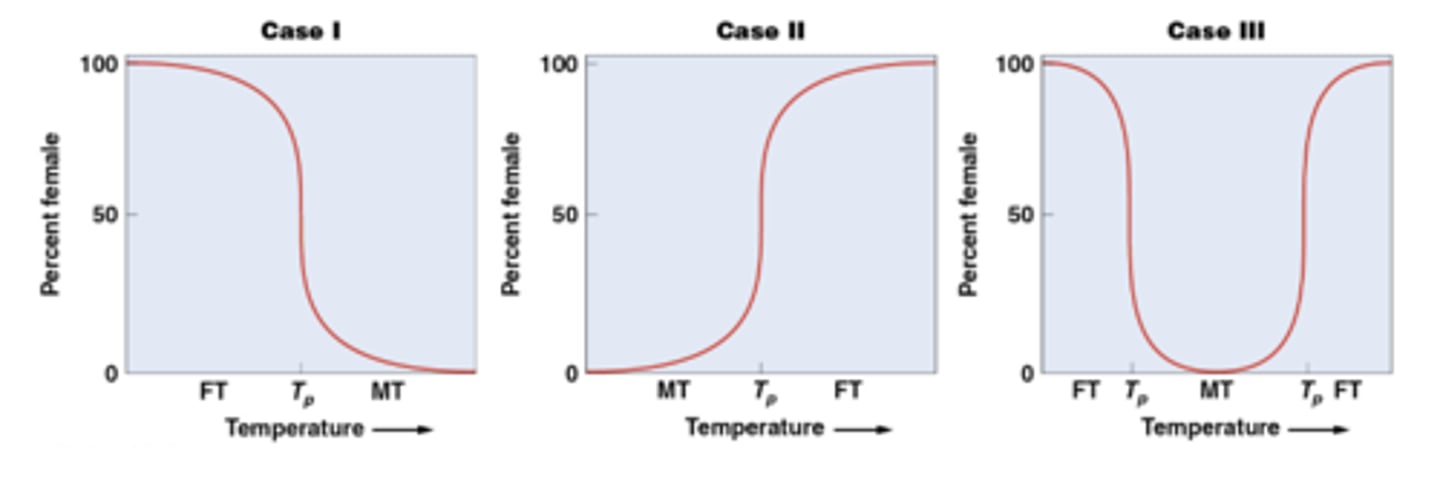
TSD temperature differed is believed to involve
steroid (mainly estrogens) and the enzymes involved in their synthesis
a particular enzyme aromatase
converts androgens to estrogens
androgens
male hormones such as testosterone
estrogens
females hormones such as estradiol
sex determining mechanisms involving estrogens seems to be
characteristic of nonmammalian veterbrates
human karyotype revealed that
one pair of chromosomes differs in males and females
-females: two X chromosomes
-males: one X and one Y
in humans the Y chromosome determines
maleness
during early human embryonic development, the embryo is
hermaphroditic
human hermaphrodite
gonadal phenotype is sexually indifferent
as development continues, gonadal ridges can form
either ovaries or testes (bipotential gonads)
bipotential gonads are triggered by
presence or absence of Y chromosome
in bipotential gonads the presence of Y chromosome alone
does NOT mean it determines maleness
the human Y chromosome
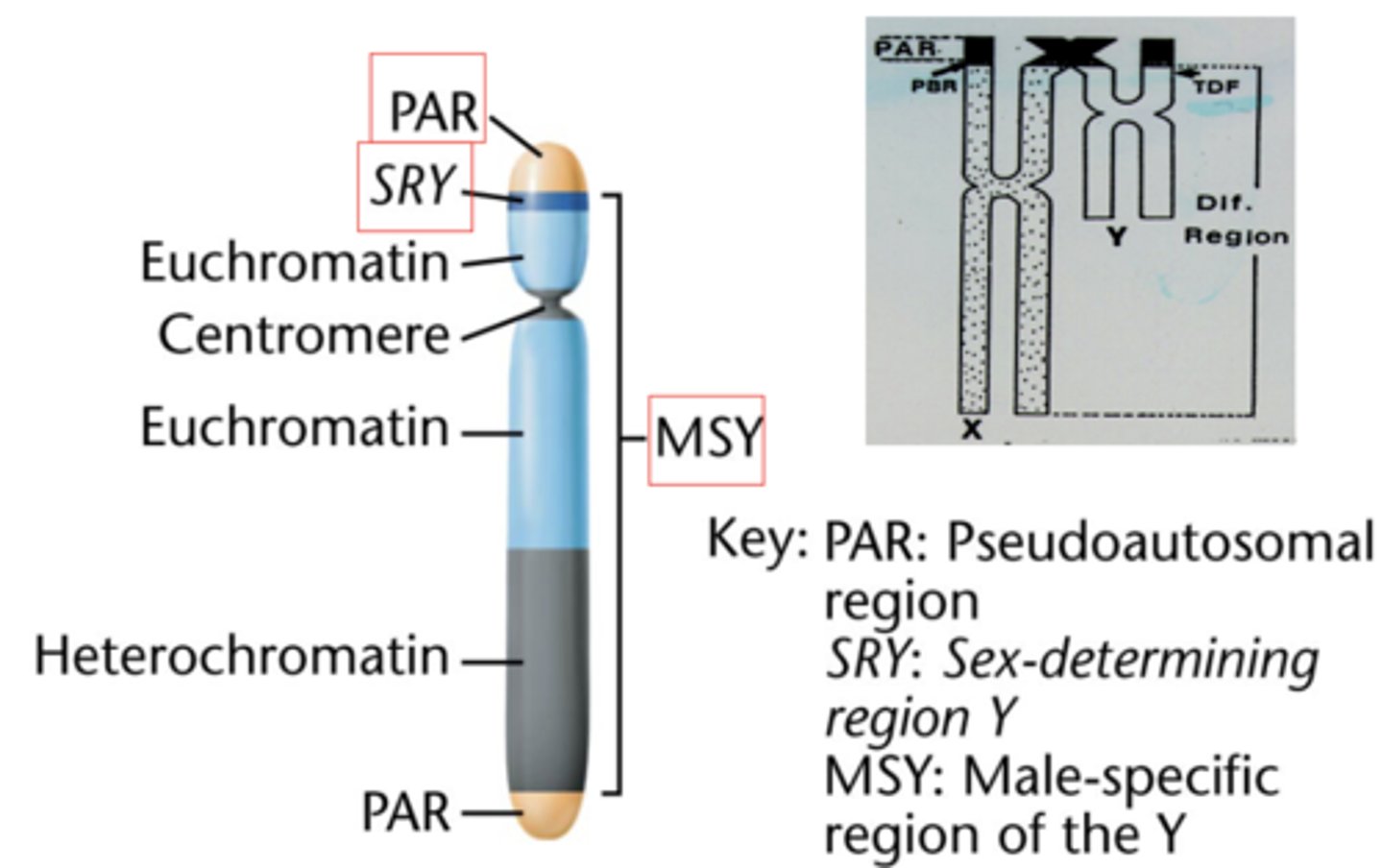
PAR
pseudoautosomal region
SRY
sex-determining region Y
MSY
male-specific creation of the Y
the Y chromosome has at least
75 genes
X chromosome has
900-1400 genes
pseudoautosmal regions (PARs) present on
both ends of the Y chromosome share homology with regions on the X chromosome + synapse + recombine with it during mitosis
PARs are critical to
segregation of the X and Y chromosomes during male gametogenesis
male-specific region of the Y (MSY)
non recombining region of the Y chromosome
some potions of MSY share
homology with the X chromosome, others do not
MSY has
euchromatic and heterochromatic regions
euchromatic regions
functional genes
heterochromatic regions
nonfunctioning genes
SRY (sex determine regions) is located
adjacent to the PAR of the short arm of the Y chromosome
at 6-8 weeks of development the SRY genes become
activate in XY embryos
SRY expressed
gonads develop into testes
SRY not expressed
gonads develop into ovaries
testis-determining factor (TDF) is a
protein encoded by a gene in the SRY that triggers testes formation
TDF is present in all
mammals
SRY codes for
TDF
evidence that TDF determines maleness
-deviations from normal sex determination
-transgenic mice research
in deviations from normal sex determination
-males with two X chromosomes and no Y
->SRY region attached to X chromosome
-females with one X chromosome and one Y chromosome are missing SRY gene
transgenic mice research shows that
XX normal mice eggs injected with DNA containing SRY transform the mice into males
TDF is believed to be the transcription factor that behaves as a
master switch controlling the genes involved in sexual differentiation
XX males have a
translocation from the Y to the X
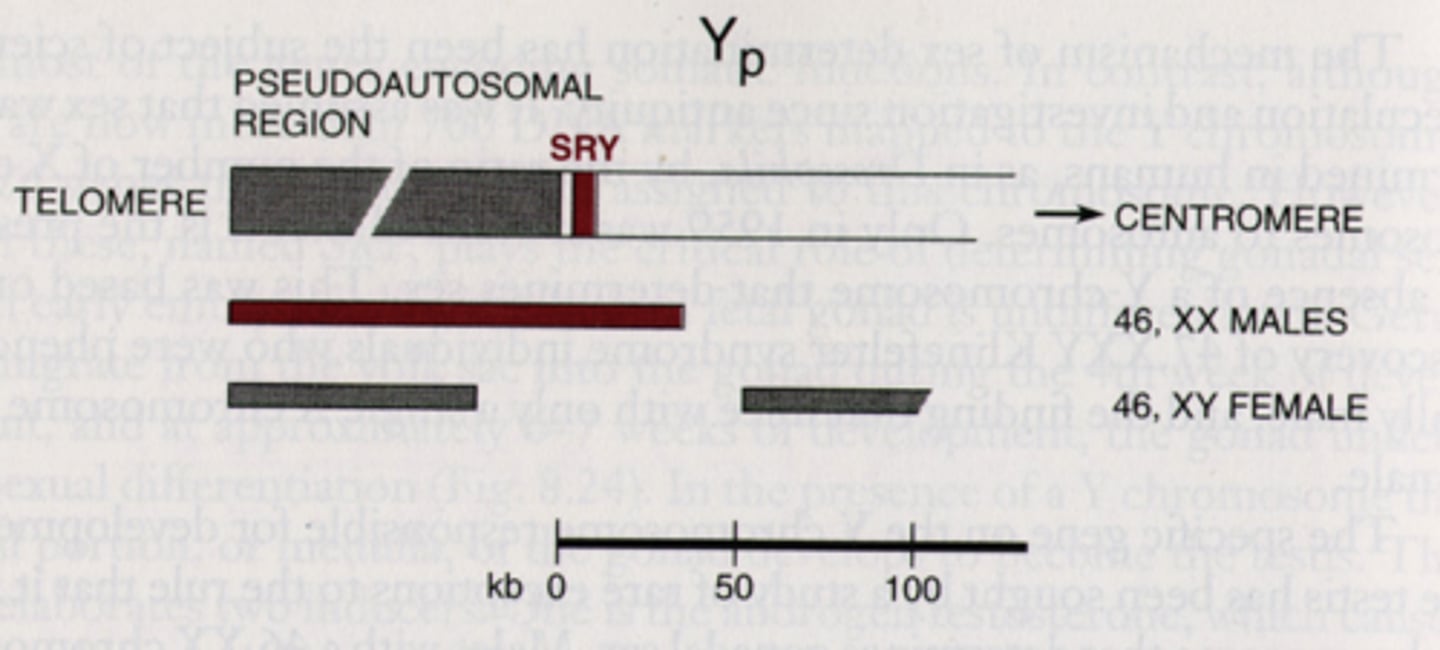
XY females have a
deletion of part of the Y
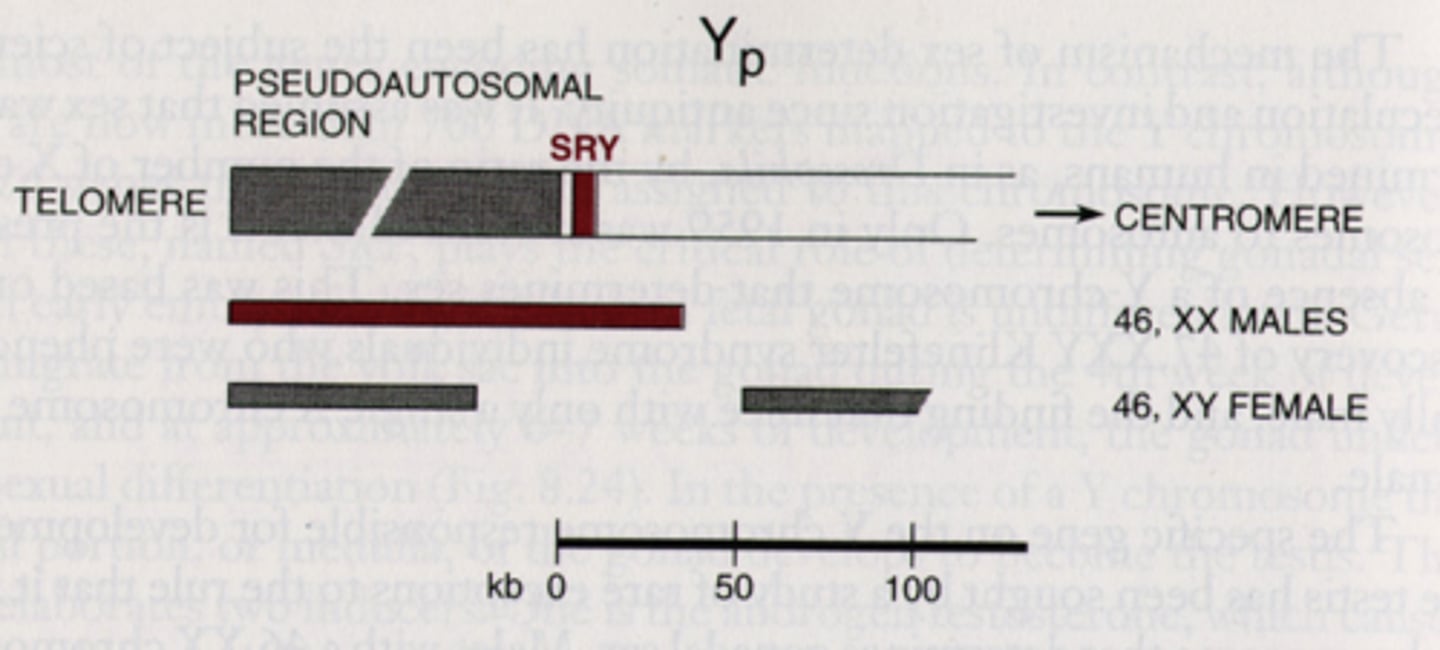
human diseases with extra X chromosomes
-klinefelter syndrome
-XXX syndrome (Triplo-X)
klinefelter syndrome
-1/660 males
-tall stature with long arms and legs
-underdeveloped testes and prostate gland
-no facial hair
-normal intelligence but slow learners
-phenotypically male
-infertile
-slight breast enlargement
-hips often rounded
klinefelter syndrome has usually
XXY or a 47,XXY, 48,XXXY, 49,XXXXY karyotype
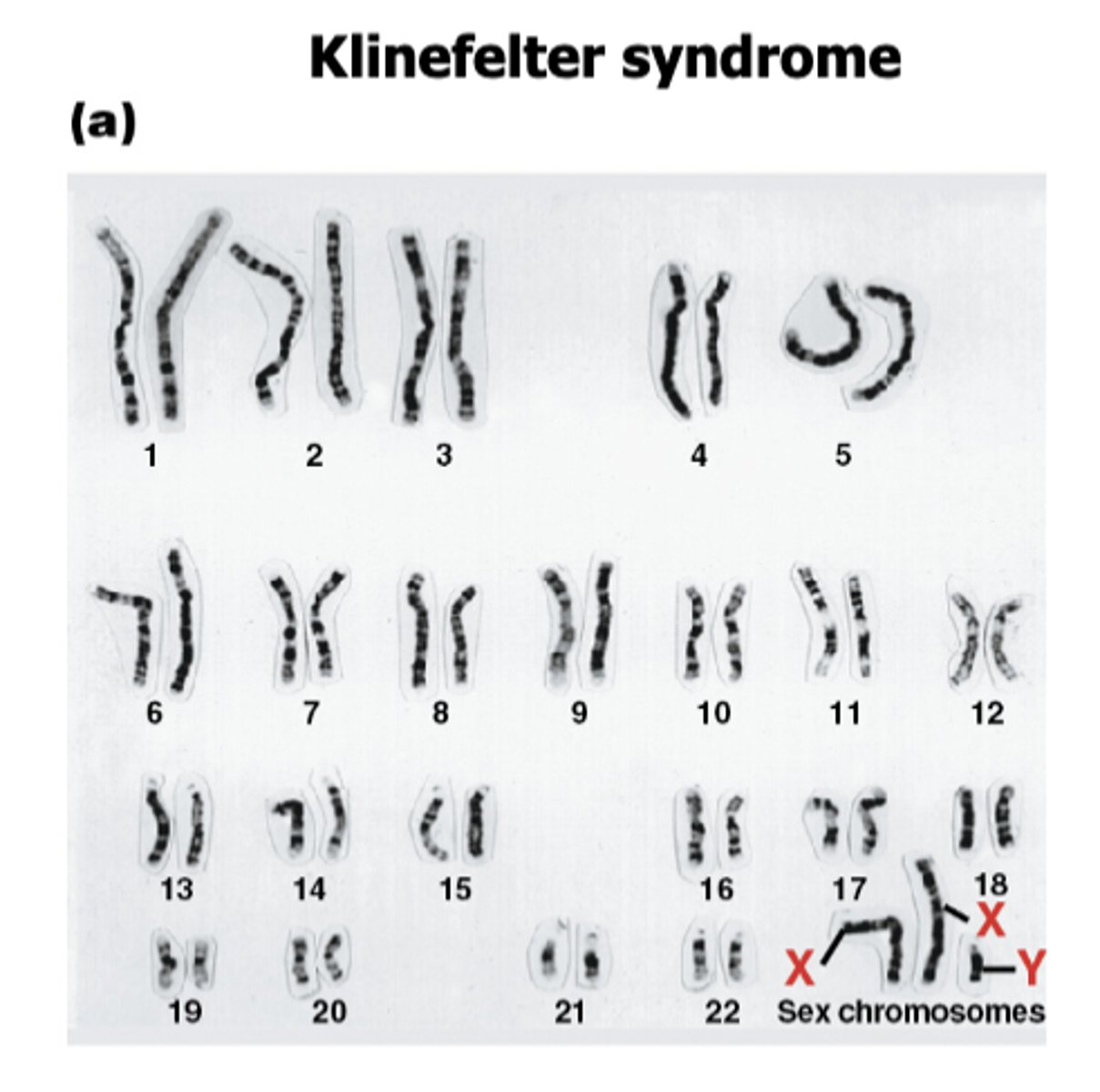
XXX syndrome (Triplo-X)
abnormal presence of three X chromosomes along with a normal set of autosomes results in female differentiation
-1/1000 live births
-47,XXX